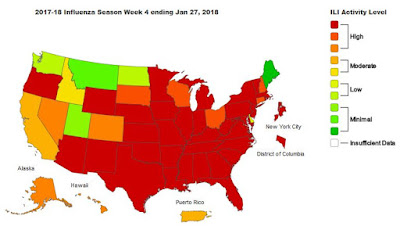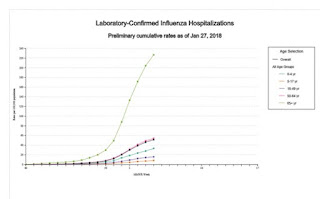#13,117
As mentioned earlier today, the CDC released their epi week 4 FluView report just after 11am this morning, while concurrently holding a press conference. A transcript & audio of that presser will be made available (hopefully later today) on the CDC Media website.
While there were hopes that this year's flu season was about to peak, this week's numbers (which reflect flu activity 1 to 2 weeks ago) show that influenza continues to increase across much of the country, although some lessening of severity has been reported in the western states.
Although the season may moderate in the weeks ahead, right now this season is on par with - or slightly ahead of - the 2014-15 `High Severe' H3N2 season.
Cumulative hospitalizations (at this stage of the epidemic) are higher (51.4 per 100,000 pop) than in any previous flu season since 2010. Hardest hit have been those over 65, followed by `Baby boomers' aged 50-64, and then by children under 5.
H3N2 continues to rule, although its share this week has dropped to below 80% with both H1N1 and influenza B gaining ground. Whether this trend continues remains to be seen.
Tragically, 16 more pediatric (under 18) deaths were reported in the last week (plus 1 from 2015-16 flu season). Pediatric deaths are often slow to be reported, and while such reports are mandatory, these numbers likely underestimate the total number of flu-related pediatric deaths.
And lastly, a good deal of time was spent discussing the low effectiveness of the H3N2 component of this year's vaccine, and yesterday's report out of Canada showing a 17% VE (vaccine effectiveness) against that particular strain.
A small spot of good news is it's effectiveness against H1N1 and influenza B (which are increasing) was considerably better.The CDC will be releasing its own mid-season VE report later this month, and similar results seem likely. While disappointing, there is some evidence that even when it doesn't prevent the flu, the vaccine may reduce the severity of one's illness (see CID Journal: Flu Vaccine Reduces Severe Outcomes in Hospitalized Patients).
An excerpt from today's FluView follows:
Weekly U.S. Influenza Surveillance Report
Week 4 ending January 27, 2018
All data are preliminary and may change as more reports are received.
Synopsis:
During week 4 (January 21-27, 2018), influenza activity increased in the United States.
- Viral Surveillance: The most frequently identified influenza virus subtype reported by public health laboratories during week 4 was influenza A(H3). The percentage of respiratory specimens testing positive for influenza in clinical laboratories remained elevated.
- Pneumonia and Influenza Mortality: The proportion of deaths attributed to pneumonia and influenza (P&I) was above the system-specific epidemic threshold in the National Center for Health Statistics (NCHS) Mortality Surveillance System.
- Influenza-associated Pediatric Deaths: Seventeen influenza-associated pediatric deaths were reported, one of which occurred during the 2015-2016 season.
- Influenza-associated Hospitalizations: A cumulative rate of 51.4 laboratory-confirmed influenza-associated hospitalizations per 100,000 population was reported.
- Outpatient Illness Surveillance:The proportion of outpatient visits for influenza-like illness (ILI) was 7.1%, which is above the national baseline of 2.2%. All 10 regions reported ILI at or above region-specific baseline levels. New York City, the District of Columbia, and 42 states experienced high ILI activity; Puerto Rico and two states experienced moderate ILI activity; three states experienced low ILI activity; and three states experienced minimal ILI activity.
- Geographic Spread of Influenza:The geographic spread of influenza in Puerto Rico and 48 states was reported as widespread; Guam and one state reported regional activity; the District of Columbia and one state reported local activity; and the U.S. Virgin Islands reported sporadic activity.
And as a side note, the sudden resignation of Dr. Brenda Fitzgerald this week may have had political ramifications, but anyone who covered the 2009 H1N1 pandemic already knows that the CDC couldn't be in better hands than those of Dr. Anne Schuchat.



